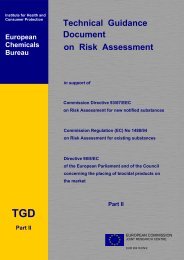Challenges of Regulation and Risk Assessment of Nanomaterials
Challenges of Regulation and Risk Assessment of Nanomaterials
Challenges of Regulation and Risk Assessment of Nanomaterials
Create successful ePaper yourself
Turn your PDF publications into a flip-book with our unique Google optimized e-Paper software.
exposure using new metrics <strong>and</strong> to develop, calibrate <strong>and</strong> validate quantitative models for<br />
occupational <strong>and</strong> consumer exposure.<br />
S. Friedrichs, as Director <strong>of</strong> the Nanotechnology Industries Association (NIA), presented the current<br />
Industry experience with conducting nanomaterial safety assessments. In order to enable the highest<br />
possible impact <strong>of</strong> the considerable financial investment that is necessary for reliable <strong>and</strong><br />
reproducible nanomaterials safety assessments, the NIA approach is that data generated in<br />
measurement/testing (research projects) on manufactured nanomaterials needs to be useable for<br />
broad policy information, (potential) regulatory compliance <strong>and</strong> prioritisation <strong>of</strong> st<strong>and</strong>ardisation. It is<br />
a requisite that research concentrates on endpoints agreed by (global) policy makers, that it makes<br />
any measurement/testing under OECD TGs or harmonised / policy-agreed adaptations in order to<br />
eventually conform with the Mutual Acceptance <strong>of</strong> Data (MAD) agreement <strong>and</strong> data are collected<br />
using the OECD Harmonised Templates which provide a comparable format which is (potentially)<br />
regulatory relevant (IUCLID).<br />
Accordingly, NIA is involved in research into the likelihood <strong>and</strong> possible pathway <strong>of</strong> exposure via<br />
inhalation arising throughout the lifecycle <strong>of</strong> a selection <strong>of</strong> commercially available articles containing<br />
carbon nanotubes. Industry has also been involved in development <strong>of</strong> techniques <strong>of</strong> detection <strong>of</strong><br />
engineered nanomaterials in the environment <strong>and</strong> the potential techniques for Nanomedicine <strong>and</strong><br />
nanotoxicolgy, the RIP-oNs projects, the NANEX project <strong>and</strong> the PROSPECT initiative.<br />
PROSPECT is a public-private partnership dedicated to supporting the safe <strong>and</strong> responsible<br />
exploitation <strong>of</strong> nanomaterials, <strong>and</strong> developing a better underst<strong>and</strong>ing <strong>of</strong> their impact on humans <strong>and</strong><br />
the environment. This initiative has published literature reviews on Cerium Oxide <strong>and</strong> Zinc Oxide, a<br />
Protocol for Nanoparticle Dispersion, Guidelines <strong>and</strong> Protocol for Sampling, an Evaluation <strong>and</strong><br />
Assignment <strong>of</strong> Nanoparticle Dispersion/Characterisation Methodologies, to be developed under<br />
PROSPECT <strong>and</strong> a Video on Dispersion Protocol. NIA has actively contribution to the implementation<br />
<strong>of</strong> the JRC repository <strong>of</strong> reference nanomaterials, helping in the characterisation <strong>of</strong> some <strong>of</strong> the NM<br />
series materials (zinc oxide, silver).<br />
NIA is a enthusiastic supporter <strong>of</strong> the JRC NANOhub as it provides a tool allowing to many scientific<br />
projects (across the globe) contributing to the OECD Sponsorship Programme to store their data <strong>and</strong><br />
generate results <strong>and</strong> individual reports. Reporting in harmonised templates necessary to enable readacross,<br />
<strong>and</strong> ‘interpolation’ <strong>and</strong> ‘extrapolation’ <strong>of</strong> results, this contributes to the value <strong>of</strong> the OECD<br />
Sponsorship Programme, that lies in the agreed, harmonised conduct <strong>of</strong> tests in many laboratories in<br />
many countries on many same representative NMs.<br />
S. Vázquez Campos presented the Nanopolytox approach for the Life Cycle <strong>Assessment</strong> <strong>of</strong><br />
<strong>Nanomaterials</strong> in Polymer Nanocomposites. Life Cycle <strong>Assessment</strong> (LCA) is a comprehensive analysis<br />
tool that can be used to evaluate how a product or material affects ecosystems <strong>and</strong> human health<br />
from its production to its end-<strong>of</strong>-life. It is currently accepted that it provides an appropriate<br />
perspective both for producers, regulators <strong>and</strong> uses to assess products <strong>and</strong> materials.<br />
Nanopolytox will use the LCA tool to establish a full underst<strong>and</strong>ing <strong>of</strong> the environmental benefits <strong>and</strong><br />
drawbacks <strong>of</strong> nanotechnology <strong>and</strong> nanomaterials compared with those <strong>of</strong> conventional technologies<br />
<strong>and</strong> products over their complete life cycles, in particular, polymeric nanocomposites <strong>of</strong> different<br />
nanomaterials (Carbon nanotubes, nanoclays <strong>and</strong> metal oxide nanoparticles) will be addressed.<br />
These nanocomposites will be studied in all their life cycle stages as: i) manufactured<br />
nanocomposites, ii) processed nanocomposites, iii) aged nanocomposites <strong>and</strong> iv) recycled<br />
nanocomposites.<br />
17








